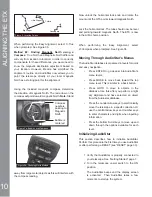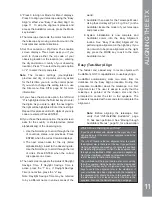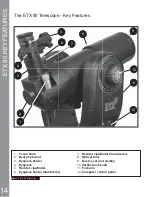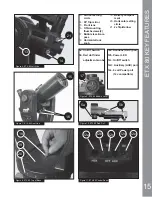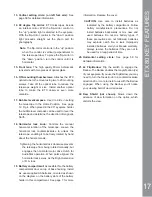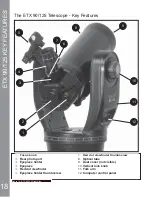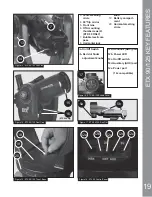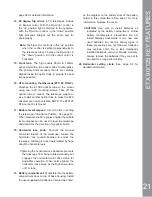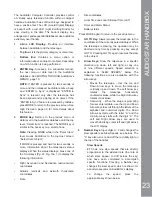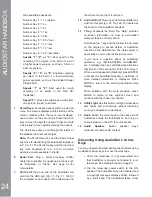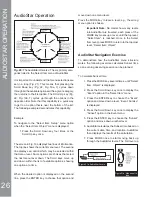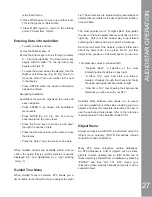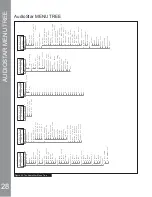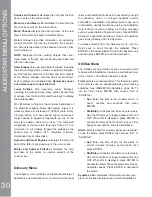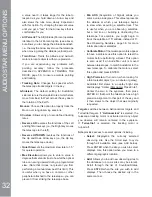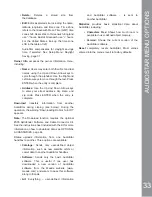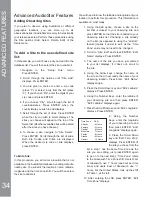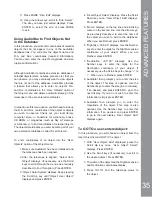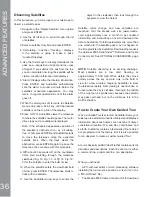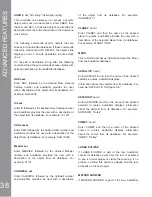
The AudioStar Computer Controller provides control
of virtually every telescope function within a compact
handbox. AudioStar has soft-touch keys designed to
have a positive feel. The LCD (Liquid Crystal Display)
is back-lit with a red LED (Light Emitting Diode) for
easy viewing in the dark. The back-lit display, key
arrangement, and sequential database make AudioStar
extremely user friendly.
1 2-Line LCD Display:
Provides an interface
between AudioStar and the telescope.
•
Top line:
Lists the primary category or menu item.
•
Bottom line:
Contains a menu option or
information about an object or subject, depending
on which function is being performed.
2 ENTER
Key:
Accesses, in a sequential manner,
the next menu or data level in the AudioStar
database. See MOVING THROUGH AudioStar’s
MENUS, page 10.
NOTE:
If ENTER is pressed for two seconds or
more and then released, AudioStar emits a beep
and “ENTER to Sync” is displayed. “ENTER to
Sync” is relevant only after the telescope has
been aligned and is pointing at an object. If the
“ENTER to Sync” feature is accessed by mistake,
press MODE to return to the previous screen. See
High Precision, page 32, for more details about
this feature.
3 MODE
Key:
Returns to the previous menu or
data level in the AudioStar database until the top
level, “Select Item” is reached. The MODE key is
similar to the back key on a smart phone.
Note:
Pressing MODE while in the “Select Item”
level moves AudioStar to the topmost screen:
“Select Item: Object”.
If MODE is pressed and held for two seconds or
more, information about the telescope’s status
displays. When the status displays, press one of
the Scroll keys (Pg. 22, Fig. 19a, 7) to display the
following information:
•
Right Ascension and Declination (astronomical)
coordinates
•
Altitude (vertical) and Azimuth (horizontal)
coordinates
•
Date
• Site
coordinates
•
Local Time and Local Sidereal Time (LST)
•
Timer and Alarm Status
• Battery
status
Press MODE again to return to the previous menu.
4 GO
TO
Key:
Slews (moves) the telescope to the
coordinates of the currently selected object. While
the telescope is slewing, the operation may be
aborted at any time by pressing any key except
GO TO. Pressing GO TO again resumes the slew
to the object.
5 Arrow
Keys:
6OHZ WKH WHOHVFRSH LQ D VSHFL¿F
direction (up, down, left, and right), at any one
of nine different speeds. Speed selection is
explained in “SLEW SPEEDS”, below. The
following functions are also available with the
Arrow keys:
• Moves the telescope – Use the Up and
Down Arrow keys to move the telescope
vertically up and down. The Left Arrow key
rotates the telescope horizontally
counterclockwise, while the Right Arrow key
rotates it clockwise.
• Data entry – When the scope is prompting
for user entered data, use the Up and Down
Arrow keys to scroll through the letters of the
alphabet and numerical digits. The Down
Arrow key starts with the letter “A” and the
Up Arrow key starts with the digit “9.” The
Left and Right Arrow keys are used to
move the blinking cursor left and right across
the LCD display.
6 Number
Keys:
Input digits 0 - 9 and changes the
slew speeds (see Slew Speeds, see below). The
“0” key also turns on and off the red utility light on
the top of the handbox.
Slew Speeds
ETX has nine slew speeds that are directly
proportional to the sidereal rate (the rate at
which stars appear to drift across the sky)
and have been calculated to accomplish
VSHFL¿F IXQFWLRQV 3UHVVLQJ D 1XPEHU NH\
changes the slew speed, which is shown for
about two seconds on AudioStar’s display.
To change the speed, press the
appropriate key shown below.
AUDIOST
AR HANDBOX
23


